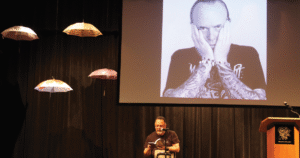
By Matt Wiley
Tampa Palms residents may notice more light coming through the trees along Yardley Way, as well as a much better view of the high voltage power transmission lines that stretch through the community on a vacant strip of property, as a Federal regulation now is requiring power companies to trim or remove trees and foliage that could interfere with those lines during a storm.
An April 2013 change to the Federal Energy Regulatory Commission (FERC)’s regulation entitled “18 CFR Part 40” strengthens a requirement for power companies to manage vegetation around high-voltage transmission lines, such as the lines that currently traverse Tampa Palms. By using a “zero tolerance” policy for vegetation management, the FERC reports that this will better safeguard the possibility of a major power outage, such as the 2003 blackout in the northeastern U.S., which was determined to have been caused in-part by unmanaged vegetation near transmission lines.
To comply with this regulation change, both TECO Power and Duke Energy have been trimming and removing trees and vegetation that either currently are coming into contact with, or have the possibility of coming into contact with, these Federally-protected transmission lines. In addition to having the potential to bring down lines, trees in close enough proximity have the potential to cause “flashovers,” which occur when power lines touch one another and can cause the lines to short-circuit.
“The transmission line in the Tampa Palms community is a critical part of the Florida transmission grid,” says Sterling Ivey, spokesman for Duke Energy. “Maintaining this line is vital to providing reliable electric service to both Duke and TECO customers in Pinellas and Hillsborough.”
Ivey explains that Duke Energy has obtained easements and agreements with local communities and property owners that allow it to build and maintain its power lines, which includes managing vegetation, including trees that may pose a threat to the reliability of the electric system (on or outside the easement).
Of the 300-ft.-wide strip of land that houses the transmission lines, Duke controls 100 ft. from the edge of the property lines to the north and east. Ivey says that trees within 50 ft. of the Duke transmission line have been, or are in the process of being, trimmed or removed.
Meanwhile, TECO controls the other 200 ft. of land on the south and west side of the power lines. None of the land is owned or controlled in any way by the Tampa Palms Community Development District (CDD) or Tampa Palms Homeowners Association (HOA).
TECO’s Cherie Jacobs explains that the power company is largely done with their vegetation management, but will continue to be in the area for two to three more weeks to finish some additional work.
“We try to find the balance between aesthetics and safety,” Jacobs says. “We know people in these communities love their trees, and that’s why the balance is so important.”
Jacobs explains that trees within 50-100 ft. of TECO lines may be removed, but that the distance varies depending upon the height and voltage of the lines. Because of this, some trees could be trimmed instead of having to be removed. Jacobs says that TECO faces significant fines if a tree causes an outage anywhere along the transmission lines.
Although the Tampa Palms CDD can’t control the trimming or removal of trees along the transmission lines, CDD spokeswoman Maggie Wilson says that something will be planted in their place, adding that the most significant tree removals are taking place along Yardley Way and Fairchild Dr.
“We’re going to mitigate the situation the best we can,” Wilson says. “We’re just waiting for (Duke and TECO) to finish.”




No comment yet, add your voice below!